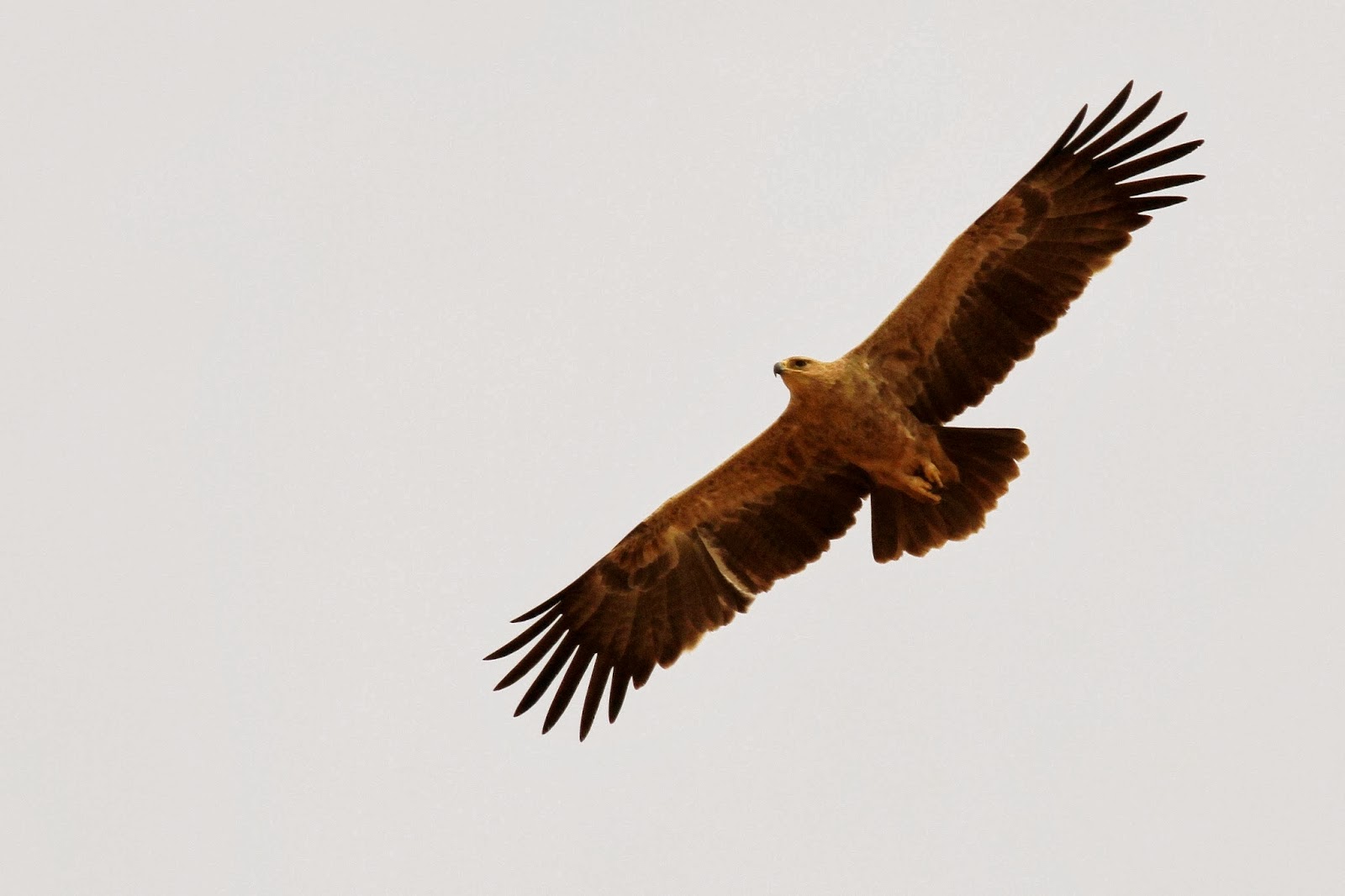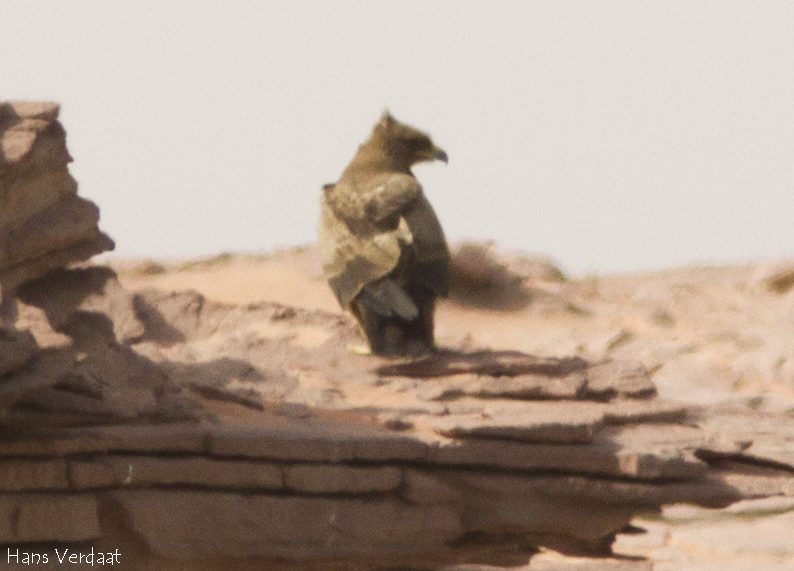Tawny Eagle in Morocco is very rare, as there have been no documented breeding pairs for over two decades.

The former breeding range of Tawny Eagle (Aquila rapax) in Morocco was much larger, however the known breeding areas in the past few decades are/were much more restricted as the species has already disappeared from the majority of the country by the 1980s. Here is a quote from the already old paper by Vernon et al. (2005):
“Now almost restricted to the Souss, Western High Atlas and Anti-Atlas. Nests in open areas of Argan, but breeding records few; most recent, all in April, were of pair at nest in Argan trees in 1980, 1990 and 1992. Numbers may be as low as a few dozen pairs”.
If the conservation status of the species was so bleak more than a decade ago, it must be even worse now. But despite this unpleasant reality, I personally don’t like using the word ‘extinct’ (Examples of why the word ‘extinct’ should be avoided are included in this blog-post about Bearded Vulture in Algeria). My opinion is probably not important, as I am by no mean an expert in this species. But does anyone believe the experts that say “species X is extinct in region or country X” without supporting their opinions with actual data collected in the field? In cases like this when no good data is available, using expressions like “probably extinct” or “almost extinct” is probably more acceptable. Comments are welcome!
Reviewing some old Tawny Eagle records
Since its creation, the Moroccan Rare Bird Committee (MRBC) has received a number of records of Tawny Eagle, and over the years has accepted some and rejected others.
An important decision made by the MRBC in 2016 was to re-analysis seven old records of “Tawny Eagle” submitted between 2002 and 2011. Of these, three observations were originally accepted and four were rejected. After the review, all these records were not accepted as Tawny Eagles (see the 22nd report of the MRBC). It should be noted that the re-analysis concerned only the records for which there was reasonable doubt (poor photos and/or insufficient descriptions necessary to separate the Tawny Eagle from the Spanish Imperial Eagle). In other words, the main purpose of the re-analysis was to ‘clean’ the records of the Tawny Eagle. In the re-analysis process, the committee was only interested if the birds were Tawny Eagles or not (because they were submitted as such). However, some of them could have been Spanish Imperial Eagles.
Why now?
Before the recent widespread use of satellite tracking, the crossing of the Strait of Gibraltar by Spanish Imperial Eagles was only noted occasionally. Similarly, (and consequently) the occurrence of the species in Morocco (and Africa in general) was considered accidental (of course, this is after the disappearance of the breeding population in the mid-1970s).
I think that for these reasons, seeing an eagle that looked like a “Tawny Eagle” in Morocco (especially in the Souss and Anti-Atlas regions) at that time was easier to be considered as a Tawny Eagle. Moreover, most of the observations could have concerned distant birds, and photography at the time did not help either (these two points are true for some of the re-analyzed birds). With improved knowledge, we know that many Spanish Imperial Eagles visit Africa during their first years, and this must have been the case a decade or so ago (even when the population was still smaller than today).
Vagrancy potential from the sub-Saharan population:
The Tawny Eagles of the Moroccan population are becoming hard to see, but we should never give up – maybe a very small relict population still hanging on at a remote place.
Apart from the local population, there is also the possibility of seeing a vagrant bird from the sub-Saharan population. There are not yet many encouraging observations, but I think it’s enough to cite that the species is occasionally observed in northern Mauritania:
– On 23 September 2014, Hans Verdaat photographed a Tawny Eagle at Cap Blanc, just inside the Mauritanian part of the peninsula (photo 1 below, observation.org). No, it’s not a Tawny but a Wahlbeg’s eagle, see the update below.
– On 29 November 2011, Jan Lok reported seeing an adult and juvenile at the southern limit of Nouadhibou (observation.org).
– On 8 April 2001, a Tawny eagle observed at Cap Timiris, Banc d’Arguin National Park (historic data entered in eBird.org).
I should add also, that in January 2017, a Dutch birding teem reported seeing a Tawny Eagle at Dakhla Bay (observation.org), but no new information have emerged since then.
Reference:
Vernon, R., Thévenot, M., Bergier, P. & Rousseau, E. 2005. Argan woodland, an important bird habitat in Morocco. Bull. ABC 12: 134-146.
Update:
Wahlberg’s Eagle (Hieraaetus wahlbergi)
When this blog-post was shared on facebook, Tom Conzemius commented on the photo: “…the small beak and tail are perfect for Wahlberg’s Eagle”. Other raptor specialists agreed about this identification, see this blog-post for details: Second record of Wahlberg’s Eagle for the Western Palearctic.

Just a thought – Perhaps the word “extirpated” is a better term?
A really interesting read, thanks! – I’d be interested to know of the true vagrancy status of Sub-sahran Tawny Eagles would be into Morocco but that is going to be unanswered until telemetry work is done, I guess.
Tawny Eagles are as you know largely sedentary, but some do disperse. In West Africa for instance individuals will make short distance movements south into the moist woodlands around October/ November and back north in April, so I do wonder what the likelihood of spread actually is – my thoughts are it would be vanishingly small.
There can be little doubt that more research needs to be done on the reasons for decline both within and outside of protected areas and telemetry may also give some answers here as well as a clearer picture of Sahelian population movements.
You are welcome and thanks for the comment as well!
You are right, technically the word ‘extirpated’ that should be used when a species is only vanished from a particular area, and ‘extinct’ when the species is gone forever (even in captivity, like the Passenger Pigeon for example). But my point is that we should use modifiers to attenuate or relativise our statements when there is no good data to support them.
I totally agree with you in regard to the Tawny Eagle being a sedentary species with limited dispersal. But some do disperse from southern Mauritanian/Senegal northwards to the limit of the WP, so there are possibilities they can also wander a bit to the north to the adjacent Oued Dahab (especially around Aousserd). However, seeing a vagrant in the Souss and Atlas regions is extremely unlikely.
The same is true for another raptor in a similar situation: the Dark Chanting Goshawk (on the verge of extinction in Morocco, and with limited dispersal south of the Sahara). Like Tawny Eagle, this species do disperse now and then to northern Mauritania.
Also agree that only a telemetry study will answer the question (among other equally important aspects) regarding the true dispersal potential for these species.
Mohamed
En complément de votre notule, et de la discussion, nos dernières obs. d’Aquila rapax en zone sahélienne de la région atlantique, coté Sénégal du fleuve…
https://ornithondar.blogspot.com/2014/01/26-un-aigle-ravisseur-lultime-aquila.html
https://ornithondar.blogspot.com/2015/12/2-laigle-ravisseur-nidifie-sur-un.html
Très cordialement. Frédéric pour Ornithondar
En Mauritanie, nous rapporte Paul Isenmann (In Oiseaux de Mauritanie, 2010), ” (…) dans les années 1970-1980, observations uniquement dans la vallée du Sénégal et sur la steppe au sud du 17e N (Gee 1984; P. Browne). L’espèce est devenue rare après avoir été l’aigle le plus abondant au Sénégal (Morel & Morel 1990), le même déclin a eu lieu probablement en Mauritanie et ailleurs en Afrique sahélienne (Thiollay 2006). Observations vers le nord jusqu’à Nouakchott, le Banc d’Arguin et Nouâdhibou (15 octobre 1973, 15-17 janvier 2000, 8-9 avril 2001, 21 juin 2005) (K. Goudswaard, Mahé 1985, Bulletin African Bird Club 8, 2001, Hagemeijer et al. 2004, Salewski et al. 2005)”
Amitiés. F.B. pour Ornithondar
Merci Frédéric pour ces commentaires très intéressants comme toujours.
En ce qui concerne l’Aigle ravisseur nichant sur un pylône de haute tension, j’ai lu avec intérêt le blog quand il a été publié. En effet, ce cas me rappelait des cas similaires chez la Buse du Maghreb qu’on a observé en 2015 (avec Rachid El Khamlichi): 3 nids sur des pylônes des lignes à haute tension au nord de Boujdour. Ce comportement est rare en Afrique du Nord chez cette espèce qui niche habituellement dans les falaises. Mais je pense que contrairement à l’Aigle ravisseur sénégalais, les Buses n’ont pas d’autre choix que de nicher sur ces pylônes car il n’y a pas de falaises dans cette région pourtant pleine de proies.
Amitiés,
Mohamed
I also THINK that I saw a tawny eagle in the area of Aoussserd (Laglat) last April but due to the rarity deemed it unsafe to report.
Hi Adrian,
It’s exactly because of its rarity that we need every potential record, so please do report your observation.
Thanks,
Mohamed